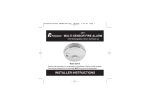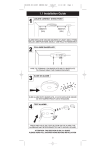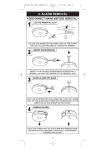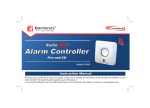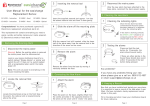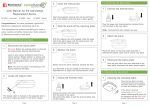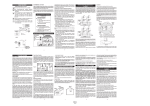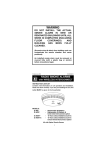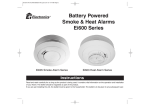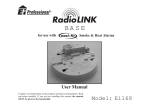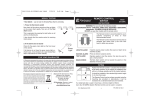Download B16351-R0-Ei2100 SERIES-USE.qxd
Transcript
B16351-R0-Ei2100 SERIES-USE.qxd 18/9/08 3:47 PM Page 1 230V~ MULTI-SENSOR FIRE ALARM with Rechargeable Lithium Cell Back-up Model: Ei2110 Contains vital information on unit operation and installation. Read and retain carefully. If you are just installing this unit this leaflet MUST be given to the householder. USER INSTRUCTIONS B16351-R0-Ei2100 SERIES-USE.qxd 18/9/08 3:47 PM Page 2 CONTENTS 1. REGULAR CHECKS 2. ALARM REMOVAL 3. IMPORTANT INFORMATION 4. MULTI-SENSOR FIRE ALARM FEATURES 5. TESTING & MAINTAINING YOUR ALARM 5.1 IF YOUR UNIT IS BEEPING 6. CLEANING YOUR ALARM 7. NUISANCE ALARMS 8. ALARM MEMORY 9. IMPORTANT SAFEGUARDS 10. PLANNING YOUR ESCAPE ROUTE 11. ALARM CONTROL 12. GETTING YOUR ALARM SERVICED 13. FIVE YEAR GUARANTEE 14. TROUBLESHOOTING 15. INDICATOR SUMMARY 2 3 4 5 7 8 10 10 12 13 14 15 17 18 18 19 21 B16351-R0-Ei2100 SERIES-USE.qxd 18/9/08 3:47 PM Page 3 1. REGULAR CHECKS Look for: Constant green light Red light flash every 40 sec. Press test button for 10 sec. Alarm will sound loudly. Vacuum around side vents to clean. 3 B16351-R0-Ei2100 SERIES-USE.qxd 18/9/08 3:47 PM Page 4 2. ALARM REMOVAL LOCATE REMOVAL SLOT INSERT SCREWDRIVER LOCATE THE ARROW ON THE FRONT FACE OF THE ALARM. THE SLOT IS LOCATED DIRECTLY ABOVE THE ARROW. INSERT A FLAT-BLADED SCREWDRIVER HORIZONTALLY ABOUT 10mm INTO THE CENTRE OF THE REMOVAL SLOT REMOVE ALARM SLIDE ALARM OFF BASE WITH THE SCREWDRIVER STILL INSERTED, PUSH THE LOWER HALF OF THE ALARM AWAY FROM THE SCREWDRIVER, IN THE DIRECTION OF THE ARROW ON THE COVER HOLD THE LOWER HALF OF THE ALARM AND REMOVE FROM THE BASE PLATE BY LOWERING THE ALARM TOWARDS THE FLOOR. 4 B16351-R0-Ei2100 SERIES-USE.qxd 18/9/08 3:47 PM Page 5 3. IMPORTANT INFORMATION Do not paint your alarm. Do not allow paint, water or dust to contaminate your alarm. Your alarm is a mains 230V AC electrical appliance. Do not open or insert anything into the alarm. Regularly check that the green mains indicator light on the cover is on. Test weekly - press and hold the Test/Hush button on the alarm for 10 seconds. The alarm will sound loudly and the red light on the cover should flash rapidly. All the other interconnected alarms should sound. If the alarm beeps and the red light flashes at the same time the battery is depleted – ensure green mains power light is on. 5 B16351-R0-Ei2100 SERIES-USE.qxd 18/9/08 3:47 PM Page 6 If a nuisance alarm occurs, press the Test/Hush button to silence the alarm for 10 minutes. Clean your alarm regularly. This will reduce the risk of false alarms. Remove or completely cover your alarm when decorating to prevent dust or other contamination damaging the unit. If your alarm sounds for no reason and will not reset, it can be removed by releasing the clip on the base. (see "ALARM REMOVAL" section on page 4). 6 B16351-R0-Ei2100 SERIES-USE.qxd 18/9/08 3:47 PM Page 7 4. MULTI-SENSOR FIRE ALARM FEATURES The state of the art EI2110 Multi-Sensor Fire Alarm, with its Heat enhanced Optical Smoke Sensor, has a significantly improved performance as described below. 1. Faster Response to a wider range of fires. The combination of the ultra fast temperature sensing thermistor and the high performance optical sensor within the unit, enhances the fire sensing performance such that the unit detects all the 7 different Test Fires (TF) specified in the standard BS ISO 7240-15: 2004. These Test Fires are designed to produce different levels of smoke/heat and as such are a good test of the units performance to the different fires that could possibly occur in the home. 2. Reduced Nuisance Alarms. The unit can tolerate up to 50% higher levels of cooking fumes and steam when compared with normal optical sensor alarms. 3. Increased Longevity and Ruggedness. The unit can tolerate up to 100% more dust and contamination build-up when compared with normal optical sensor alarms. This is due to the unique automatic DUST* compensation built into the unit which monitors the contamination in the smoke sensing chamber and adjusts the alarm trigger point accordingly. *DUST – Dust Ups Sensor Threshold. Additionally, the optical sensor chamber features a fine mesh insect screen that is bonded to the plastic of the chamber. This significantly improves immunity to insect contamination. 7 B16351-R0-Ei2100 SERIES-USE.qxd 18/9/08 3:47 PM Page 8 4. Replace Alarm Indicator. If the optical sensor chamber becomes very heavily contaminated, the amber fault light will flash once every 40 seconds to inform the user. Action can then be taken to replace the unit, long before the contamination causes nuisance alarms. 5. Alarm Memory. After a the unit has gone into alarm, the red alarm light will flash twice (1 second apart) every 40 seconds to indicate that the unit has alarmed in the previous 24 hours. Additionally, pressing the test button on this unit will cause it to emit short, rapid beeps instead of the normal alarm sound. Both these features allow easy identification, for example, of the source of nuisance alarms during the night. 6. Single Person Interconnect Test Pressing and holding the test button on the unit causes the alarm to sound. On releasing the test button, the alarm will immediately cease but all interconnected alarms will continue to sound for 3 seconds. This allows easy audible check of alarm interconnection. 5. TESTING & MAINTAINING YOUR ALARM INSPECTION & TESTING PROCEDURE Check all your alarms weekly, and also after initial installation or after re-occupation (e.g. following a holiday): (i) Check that the green mains indicator light is on. (If it is off check circuit breakers, fuses and wiring etc.) Check the red light on the cover flashes every 40 seconds. 8 B16351-R0-Ei2100 SERIES-USE.qxd 18/9/08 3:47 PM Page 9 (ii) Press the test button for up to 10 seconds and ensure that the alarm sounds. This tests the sensors, electronics and sounder are working. A red light on the cover will flash while the alarm is sounding. The alarm will stop when the button is released. Pressing the test button simulates the effect of smoke and heat during a real fire and is the best way to ensure the alarm is operating correctly. WARNING: DO NOT TEST WITH FLAME This can set fire to the alarm and damage the house We do not recommend testing with smoke or heat as the results can be misleading unless special apparatus is used. (iii) Check for any sign of contamination such as cobwebs or dust and clean the alarm as described in the “CLEANING YOUR ALARM” section on page 10, if necessary. (iv) Interconnected alarms only - Test the first unit by pressing the test button for 10 seconds. All the units should alarm within 10 seconds of the first horn sounding. After releasing the test button, the local horn will stop sounding immediately and the interconnected units will be heard sounding in the distance for a further 3 seconds. The red light on the first unit only will flash about twice a second. Check all the other units similarly in turn. (v) Check the functioning of the mains battery back-up directly after installation and then at least yearly as follows: - Turn off the mains power at the distribution board and check that the green indicator light is extinguished. - Press the Test/Hush button for up to 10 seconds and ensure the horn sounds loudly. - Monitor the alarm over a 3 minute period for any beeps. 9 B16351-R0-Ei2100 SERIES-USE.qxd 18/9/08 3:47 PM Page 10 Turn on the mains supply at the distribution board only if the unit passes the above test. 5.1 If the unit is beeping The alarm automatically monitors the battery every 40 seconds to ensure that it is satisfactory. If it is depleted it will give a short beep every 40 seconds. (i) Check that the green mains power light is on. If it is off the alarm is not receiving mains power and is being powered from its internal back-up cells. The beeps indicate that these cells are depleted. The cells are not replaceable. Check fuses, circuit breakers and wiring to determine the cause of the interruption to the mains power. If in doubt contact a qualified electrician. Once mains power is reinstated, the beeps should cease within 2 hours as the cells charge up. Fully charged, the cells will provide up to 6 months back-up without mains power. (ii) If the unit beeps and the amber light flashes at the same time it indicates a problem with the smoke sensor or the heat sensor - see “GETTING YOUR ALARM SERVICED” section on page 18. If all of the above possible causes of beeps have been ruled out, but the beeping has still persisted for over 2 hours with the green light on, there may be some other problem with the unit. The alarm must be returned for repair or replacement - see “GETTING YOUR ALARM SERVICED” section on page 18. 6. CLEANING YOUR ALARM WARNING: Electrical shock hazard. Disconnect the AC mains power at the fuse box or circuit breaker powering the alarm before following the cleaning instructions. Clean your alarm regularly (at least once every 4 weeks). In dusty areas it may be 10 B16351-R0-Ei2100 SERIES-USE.qxd 18/9/08 3:47 PM Page 11 necessary to clean the alarm more frequently. Use the narrow nozzle attachment of your vacuum cleaner to remove dust, insects and cobwebs from the sides and cover slots where the smoke/heat enters. To clean the cover, wipe with a damp cloth then dry thoroughly with a lint free cloth. WARNING: Do not paint your Alarm. If the amber light flashes on the unit every 40 seconds (without a beep) it indicates that the optical sensor chamber is contaminated. The entire unit must be replaced if it is over 10 years old (see “replace by” date on the label on the side of the unit) or if it is less than 10 years old the unit can be returned for servicing - see “GETTING YOUR ALARM SERVICED” section on page 18. Automatic Dust Compensation. The alarm monitors the contamination build-up in the chamber and then slowly compensates for it over about a 5 hour period - this is to ensure that a slow burning smouldering fire over a long period is not confused with dust build-up. If the contamination has occurred quickly (e.g. due to dust from carpets being replaced) and the alarms are sounding, the dust compensation may take some hours to operate. In this situation remove the alarm from the ceiling, leave it disconnected for 5 minutes, then reinstall the unit (the air must be clean i.e. dust and smoke free). The dust compensation will now operate quickly within 45 seconds. Other than the cleaning described above, no other customer servicing of this product is required. Servicing/repairs, when needed, must be performed by the manufacturer. All alarms are prone to dust and insect ingress which can cause false alarms or failure to alarm. The latest design, materials and manufacturing techniques have been used in the construction of our alarms to minimize the effects of contamination. However it is impossible to completely eliminate the 11 B16351-R0-Ei2100 SERIES-USE.qxd 18/9/08 3:47 PM Page 12 effect of dust and insect contamination, and therefore, to prolong the life of the alarm you must ensure that it is kept clean so that excess dust does not build up. Any insects or cobwebs in the vicinity of the alarm should be promptly removed. In certain circumstances even with regular cleaning, contamination can build up in the smoke sensing chamber causing the alarm to sound or fail. If this happens the alarm must be returned to us for servicing or replacement. Contamination is beyond our control, it is totally unpredictable and is considered normal wear and tear. For this reason, contamination is not covered by the guarantee. 7. NUISANCE ALARMS If an alarm sounds and you have thoroughly investigated and are sure that it is just a nuisance alarm, simply press the Test/Hush button briefly to silence the unit for 10 minutes. If, when the alarm goes off, there is no sign of smoke, heat or noise to indicate that there is a fire, you should get your family into a safe place, before you start investigating. Check the house carefully in case there is a small fire smouldering somewhere. Check whether there is some source of smoke or fumes, for example cooking fumes being drawn past the alarm by an extractor. If there are frequent nuisance/false alarms it may be necessary to re-locate the device away from the source of the fumes. If for some reason the alarm continues to sound without smoke or heat being present (due to insect/dust contamination for example) the unit can be silenced by disconnecting the mains power and removing the unit - see “ALARM REMOVAL” section on page 4. If cleaning the alarm does not solve the problem it can be returned for servicing/repair or replacement - see “GETTING YOUR ALARM SERVICED” section on page 18. 12 B16351-R0-Ei2100 SERIES-USE.qxd 18/9/08 3:47 PM Page 13 Hush Feature The alarm has a combined Test/Hush Button to help you control nuisance false alarms. To silence a false alarm, press the Test/Hush Button located on the cover. The alarm will automatically switch to a reduced sensitivity condition (very large levels of smoke from a nearby fire will override the Hush on the Smoke Alarms). It will not completely disable the alarm. This condition allows unwanted alarms to be silenced for a period of approximately 10 minutes. When in ‘Hush’ mode the unit will flash the red light every 8 seconds (instead of the normal 40 seconds) to indicate the sensitivity is reduced. On interconnected alarms, pressing the Test/Hush Button on the unit sensing smoke or fire (i.e. the one with the red light flashing twice every second) will silence all alarms. Pressing the Test/Hush Button on any other alarm will not cancel the alarm. The unit will reset to normal sensitivity at the end of the 10 minute ‘Hush’ period. If additional silenced time is required, simply push the Test/Hush Button again. 8. ALARM MEMORY After a unit has gone into alarm, it will flash the red indicator light twice (1 second apart), every 40 seconds. This will continue for the following 24 hours to indicate that the unit has previously alarmed. After this time, this memory will automatically reset. Alternatively, pressing the Test/Hush button will also reset the memory. Additionally, pressing the test button on this unit will cause it to emit short, rapid beeps instead of the normal alarm sound. Both these features allow easy identification, for example, of the source of nuisance alarms during the night. This memory can be very helpful after the entire system has gone into alarm and then stopped, for no obvious reason. 13 B16351-R0-Ei2100 SERIES-USE.qxd 18/9/08 3:47 PM Page 14 Once the alarm has been identified, appropriate action can be taken e.g. ensure kitchen or bathroom doors are kept closed to prevent cooking fumes or steam reaching the alarm, locate the alarm further away from the source of fumes, replace the unit if its thought to be defective or remove the unit in the short term. 9. IMPORTANT SAFEGUARDS When a fire alarm system is installed, basic safety precautions should always be followed, including those listed below: • Please read all instructions. • Rehearse emergency escape plans so everyone at home knows what to do in case the alarm sounds. Further information can be obtained from your local fire prevention officer. • To maintain sensitivity to smoke/heat, do not paint or cover the alarm in any manner and; do not allow cobwebs, dust or grease to accumulate. • If the alarm has been damaged in any way or does not function properly, do not attempt a repair. Return the alarm - see “GETTING YOUR ALARM SERVICED” section on page 18. • This appliance is only intended for premises having a residential type environment. • Fire/Smoke/Heat Alarms are not a substitute for insurance. The supplier or manufacturer is not your insurer. • Do not dispose of your alarm in a fire. 14 B16351-R0-Ei2100 SERIES-USE.qxd 18/9/08 3:47 PM Page 15 10. PLANNING YOUR ESCAPE ROUTE Use the Test/Hush Button on the alarm to familiarise your family with the alarm sound and practice fire drills regularly with all family members. Draw up a floor plan that will show each member at least 2 escape routes from each room in the property. Children tend to hide when they don’t know what to do. Teach children how to escape, open windows, and use roll up fire ladders and stools without adult help. Make sure they know what to do if the alarm goes off. 1. Check room doors for heat or smoke. Do not open a hot door. Use an alternate escape route. Close doors behind you as you leave. 2. If smoke is heavy, crawl out, staying close to floor. Take short breaths, if possible, through a wet cloth or hold your breath. More people die from smoke inhalation than from flames. 3. Get out as fast as you can. Do not stop for packing. Have a prearranged meeting place outside for all family members. Check everybody is there. 15 B16351-R0-Ei2100 SERIES-USE.qxd 18/9/08 3:47 PM Page 16 4. Call the Fire Brigade immediately on a mobile phone or from a neighbour's house. Make sure to call the Brigade for all fires no matter how small - fires can suddenly spread. Also call the Brigade even if the alarm is automatically transmitted to a remote manned centre - the link may have failed. 5. NEVER re-enter a burning house. Limitations of Fire Alarms Fire Alarms have significantly helped to reduce the number of fire fatalities in countries where they are widely installed. However independent authorities have stated that they may be ineffective in some circumstances. There are a number of reasons for this: • The alarms will not work if the mains power is off and the battery back-up is depleted. NOTE: Constant exposure to high or low temperatures or high humidity may reduce the life of the battery. • Alarms will not detect fire if sufficient smoke / heat does not reach the alarm. Smoke / heat may be prevented from reaching the alarm if, for example, the fire is too far away, if the fire is on another floor, behind a closed door, in a chimney, in a wall cavity, or if the prevailing air draughts carry the smoke / heat away. Installing alarms on both sides of closed doors and installing more than one alarm as recommended in the ‘INSTALLER 16 B16351-R0-Ei2100 SERIES-USE.qxd 18/9/08 3:47 PM Page 17 INSTRUCTIONS’ booklet significantly improves the probability of early detection. Installing an LD1 system gives the best coverage. • The alarm may not be heard. • The alarm may not wake a person who has taken drugs or alcohol. • Alarms may not detect every type of fire to give sufficient early warning. • Alarms don’t last indefinitely. For example if there is a build up of contamination then the performance of the alarm will be impaired. It is recommended that alarms are replaced after 10 years as a precaution (see ‘replace by’ date on the side of the unit). 11. ALARM CONTROL (OPTIONAL) A Remote Control Switch (Ei1529RC) is available as an optional accessory. It allows the user to perform the following functions from a remote location: LOCATE - If the alarms sound press Locate to allow the source of alarm to be identified audibily. HUSH - Press Hush to silence nuisance alarms. TEST - Operate weekly to Test the alarms. MAINS CHECK - Test will not work with mains absent. 17 B16351-R0-Ei2100 SERIES-USE.qxd 18/9/08 3:47 PM Page 18 12. GETTING YOUR ALARM SERVICED If your Alarm fails to work after you have carefully read all the instructions, checked the unit has been installed correctly, and is receiving AC power (green light on) contact Customer Assistance at the address given at the end of this leaflet. If it needs to be returned for repair or replacement put it in a padded box and send it to “Customer Assistance and Information” at the nearest address given on the Alarm or in this leaflet. Do not slide the alarm on to the mounting plate as this connects the battery and the unit may beep or alarm in the post. State the nature of the fault, where the Alarm was purchased and the date of purchase. 13. FIVE YEAR GUARANTEE Ei Electronics guarantees this Alarm for five years from date of purchase against any defects that are due to faulty materials or workmanship. This guarantee only applies to normal conditions of use and service, and does not include damage resulting from accident, neglect, misuse, unauthorised dismantling, or contamination howsoever caused. This guarantee excludes incidental and consequential damage. If this Alarm should become defective within the guarantee period, it must be returned to Ei Electronics, with proof of purchase, carefully packaged, with the problem clearly stated. (see “GETTING YOUR ALARM SERVICED”) We shall at our discretion repair or replace the faulty unit. Do not interfere with the Alarm or attempt to tamper with it. This will invalidate the guarantee, but more importantly may expose the user to shock or fire hazards. This guarantee is in addition to your statutory rights as a consumer. 18 B16351-R0-Ei2100 SERIES-USE.qxd 18/9/08 3:47 PM Page 19 14. TROUBLESHOOTING 1. FREQUENT NUISANCE ALARMS OCCUR: (1) Close kitchen / bathroom door when in use. (2) Ensure that the alarm is sited at least 6m away from sources of fumes. (3) Contamination from insects, paint or paint fumes may have occurred. Clean the alarm see “CLEANING YOUR ALARM” section on page 10. (4) If the problem persists, resiting of the alarm should be considered. 2. ALARM SOUNDS FOR NO APPARENT REASON: (1) Identify the alarm source. On interconnected units, while they are in alarm, the red light on the cover will flash rapidly only on the unit which is the source of the alarm. If an alarm has detected fire, the red LED will flash twice (1 second apart) every 40 seconds for 24 hours (or until the test button is pressed, which ever is the shorter). If an optional Ei1529RC Remote Control Switch is installed, press Locate when the system is sounding to identify the source of the alarm. (2) Check for fumes, steam etc. from the kitchen or bathroom. Paint and other fumes can cause nuisance alarms. (3) Press the Test/Hush button to silence the alarm for 10 minutes. (4) If alarm does not stop, switch off the mains and remove the unit - see “ALARM REMOVAL” section on page 4. Only remove the alarm with the rapidly flashing red light. 19 B16351-R0-Ei2100 SERIES-USE.qxd 18/9/08 3:47 PM Page 20 3. REGULAR OR IRREGULAR SINGLE BEEPS: Check the green mains power light is on. If not, check the fuse, circuit breakers and wiring connections. If the green light is off, the internal back-up cells will deplete after some months and will need to be recharged. Reinstate the mains supply to the alarm and the back-up cells will automatically recharge. If the mains has been reinstated for a number of hours and the beeps have not ceased, a fault may exist. Switch off the mains,remove the unit - (see “ALARM REMOVAL” section on page 4) and return it to the nearest address given at the end of this leaflet - see “GETTING YOUR ALARM SERVICED” section on page 18. If the beep occurs at the same time as the amber light on the cover is flashing, then one of the sensors may be defective. Switch off the mains, remove the unit (see “ALARM REMOVAL” section on page 4) and return it to the nearest address given at the end of this leaflet - see “GETTING YOUR ALARM SERVICED” section on page 18. 4. INTERCONNECTED ALARMS DO NOT ALL SOUND: (1) Hold Test/Hush button for 10 seconds after first alarm has sounded to ensure the interconnect signal is transmitted to all units. (2) One or more of the connections may not be correctly connected. We recommend you consult a qualified electrician. 20 B16351-R0-Ei2100 SERIES-USE.qxd 18/9/08 3:47 PM Page 21 15. INDICATOR SUMMARY GREEN LIGHT RED LIGHT 1.1. Standby Mains On ON 1 flash/40 sec 1.2. Mains Off OFF 1 flash/40 sec MODE AMBER LIGHT HORN BEEP ON 2 flashes/sec 2.1. Sensing Fire itself HORN ALARM 2.2. External Fire Signal (on Interconnect or RadioLink) ON 3. Low Power Back-up Cells (beep and red flash simultaneous) 1 flash/40 sec 4. Hush mode after Test/Hush Button pressed. Auto resets after 10 minutes 1 flash/8 sec 5. Memory – after fire sensed (Resets after 24 hours or button test) 2 flashes 1 sec apart every 40 sec 1 beep/40 sec Horn “chirps rapidly” on first button test 6. Replace Unit excessively contaminated 1 flash/40 sec 7. Either Sensor Defective (beep and amber flash simultaneous) 1 flash/40 sec 8. Pressing the Test button or Remote Testing (with Ei1529RC or RadioLINK Ei411H) 2 flashes/sec 21 1 beep/40 sec ON B16351-R0-Ei2100 SERIES-USE.qxd 18/9/08 3:47 PM Page 22 The crossed out wheelie bin symbol that is on your product indicates that this product should not be disposed of via the normal household waste stream. Proper disposal will prevent possible harm to the environment or to human health. When disposing of this product please separate it from other waste streams to ensure that it can be recycled in an environmentally sound manner. For more details on collection and proper disposal, please contact your local government office or the retailer where you purchased this product. Construction Product Type: Smoke Alarm Devices European Standard: EN14604:2005 Certificate of Conformity: 0086-CPD-537430 MODEL Ei2110 TYPE Multi-Sensor Fire Alarm 0086 08 22 B16351-R0-Ei2100 SERIES-USE.qxd 18/9/08 23 3:47 PM Page 23 B16351-R0-Ei2100 SERIES-USE.qxd 18/9/08 3:47 PM Page 24 Aico Ltd. Mile End Business Park, Maesbury Rd, Oswestry, Shropshire SY10 8NN, U.K. Tel: 0870 758 4000 www.aico.co.uk Ei Electronics. Shannon, Co Clare, Ireland. Tel: 061 471277 www.eielectronics.com © Ei Electronics 2008 P/N B16351 Rev0 24
























